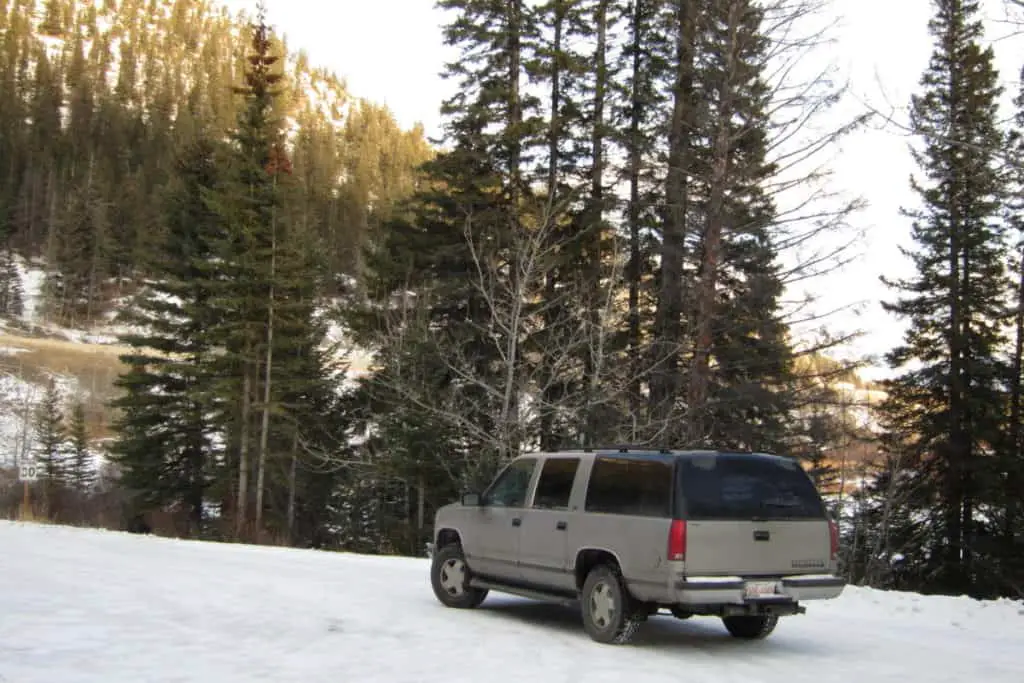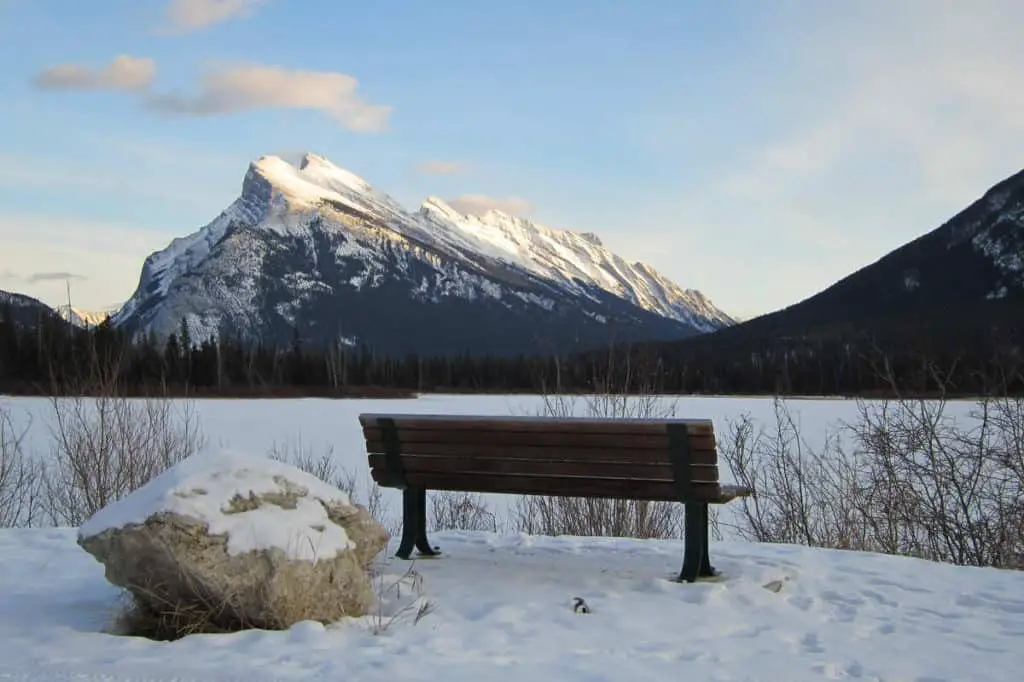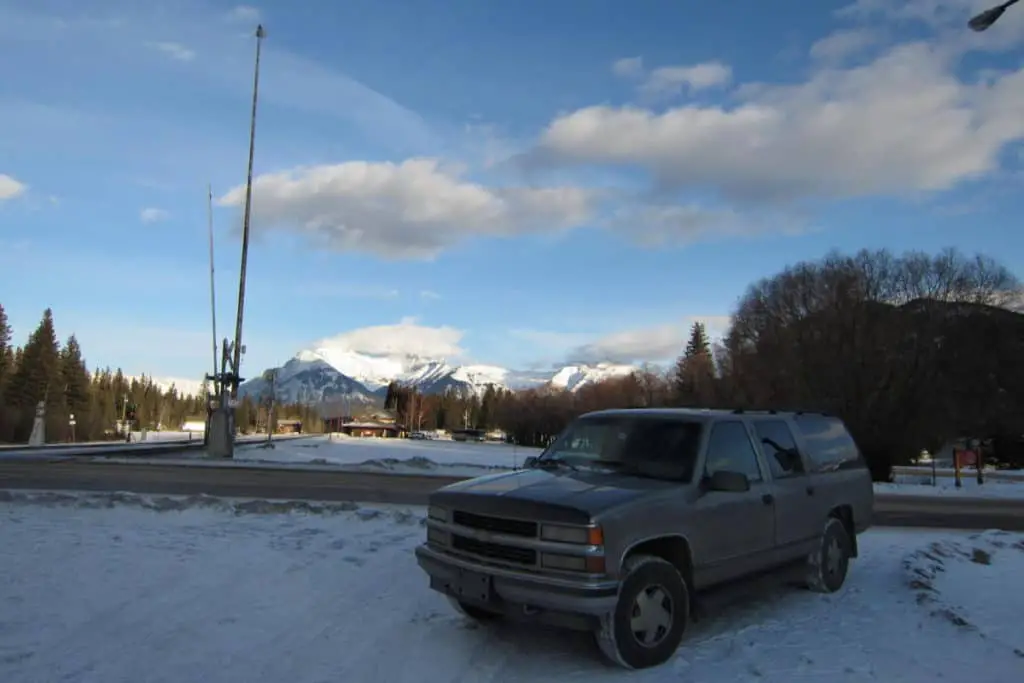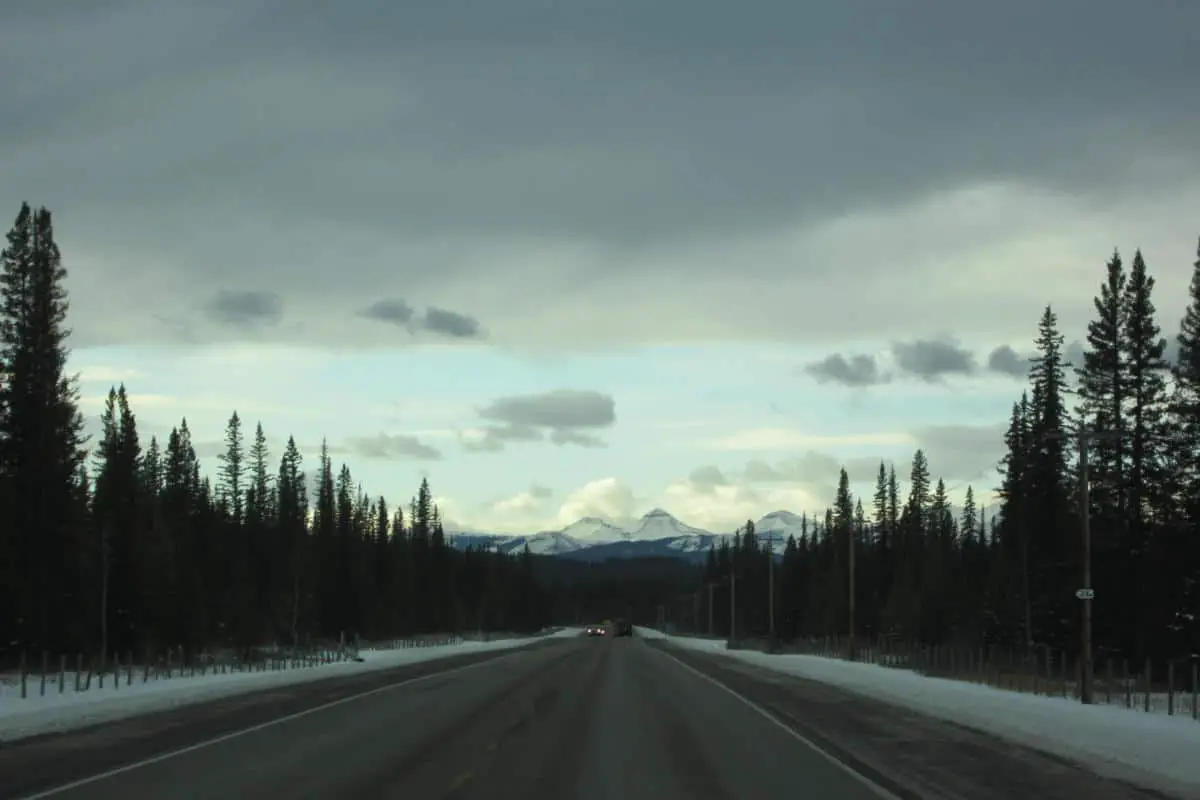When visiting Banff National Park in winter you might face difficult driving conditions due to snow and ice. If you’re planning to visit Banff in the coldest months it’s good to know what the driving will be like, what to be aware of and what to do about it. In this article you’ll read everything you need to know.
I must admit that winter driving in Banff National Park wasn’t as daunting as I initially expected, but I did experience several bumps on the road that would’ve made the trip a nightmare if I hadn’t come prepared.
This comprehensive travel guide should help you make your trip to Banff National Park in winter rather smooth sailing!
How Hard Is Driving in Banff in Winter?
Driving in Banff isn’t all that difficult with a properly winterized vehicle. The roads in Banff are spacious and clear, with little to no road deformities. You’ll have to keep your eyes open for animals and slippery roads, but you should be fine as long as you drive at a comfortable and safe speed.
Enjoy the scenery, but don’t let yourself be too engrossed by the beautiful Winterland around you while driving. If you find your eyes lingering on a scenic spot, park your car on the side of the road and give yourself a few minutes to appreciate the surrounding area.
Does Driving in Winter in Banff Require Snow Chains?
Driving in winter in Banff National Park requires snow chains in specific areas. They are required by law when driving the Icefields Parkway (Highway 93 North), Banff-Windermere Highway (Highway 93 South), and most other roadways, except for highways 1 and 16.
If you’re just planning to stay at the townsite, you won’t need to equip your vehicle with snow chains. However, it’s still better safe than sorry. Weather conditions in Banff can be unpredictable at best, so it’s always a good idea to pack up some snow chains for “just in case” scenarios.
What Are the Main Difficulties When Driving in Banff in Winter?
Banff’s winter season lasts approximately three months, from November to mid-February.
Temperatures reach an average low of -13˚C (7°F) and a high of -5˚C (23°F), but negative temperatures aren’t uncommon. In fact, it had dropped to the negative thirties not so long ago! As such, visitors must be especially careful when exploring the area.
Snow turns Banff into a magical wonderland, but looks can be deceiving. In the wintertime, driving in Banff opens up several difficulties that might put off the average tourist. Here are some driving hazards to take note of!
Ice on the Road
In Banff, ice on the road is one of the most significant driving hazards you’ll face. Since ice isn’t always visible, it can cause total loss of control of your vehicle.
Surface ice and black ice make steering and stopping a difficult endeavor. The latter is more dangerous than the former, as its thin layers make the road look wet instead of icy.
Unlike surface ice, which can be spotted even miles away, black ice often goes unnoticed until you hit a patch and lose control of the car.
Unfortunately, black ice is quite common on the roads of Banff. For this reason, you should always drive slowly to decrease the risk of ice-related accidents. If nothing else, it’ll at least give you time to come to a complete stop if you do lose control.
Poor Visibility
Rain, fog, and snow are expected in Banff, especially during the earlier winter months. Unless you’re willing to stay in a hotel for a couple of weeks until the weather clears out, you’ll inevitably face poor visibility when driving to whatever destination you’re visiting.
Don’t use your high beams or headlights when driving in poor visibility. High beams will reflect the light back to you, further impairing visibility.
Instead, drive with lights on low beams or use fog lights if you have them.
Lack of Cell Reception
Cell coverage is depressingly limited in Banff National Park. Unless you have a satellite phone, it’ll be difficult to call anyone or use Google Maps while driving.
Reception can be found in some roadside locations, but this is far and few in between. It works perfectly in the townsite, but it’s spotty on highways 1 and 1A and practically nonexistent north of 93. There’s also no cell coverage along the Icefields Parkway between Jasper and Lake Louise.
Though it isn’t necessarily a driving difficulty, the lack of cell reception can make the drive distressing if it’s your first time in Banff. You’ll have to rely on physical maps, road signs, satellite communication devices, and the kindness of the locals to get to the destination you’re driving to.
Limited Gas Stations
When driving along the more secluded parts of Banff National Park, you’re less likely to find a serviceable gas station. There aren’t a lot of gas stations along Highway 1 and Highway 93.
There’s one gas station along the Icefields Parkway and several in Lake Louise, but you won’t spot another station for miles.
Running out of gas in the middle of nowhere is stressful enough, but running out of gas in Banff with little to no reception is a different brand of nightmare.
To avoid this, always full up before going on a drive around Banff, even if you’re planning to get home early.
How Safe Are Banff Roads in Winter?

Aside from the occasional snowstorm and slippery highway, driving around Banff in winter is generally safe.
The Canadian Rockies are properly maintained and regularly cleared of snow. Some roads would be closed due to avalanche hazards, but clearing is quick and efficient. Usually, blockages would be opened up within a few days, if not a few hours.
But though safe, always take precautionary measures when driving to and around Banff National Park.
Pay attention to weather reports and regularly tune in to local radio stations and news outlets. You’ll occasionally find animals crossing the road, so drive carefully and pay close attention to your surroundings.
In Banff, most roads will have some degree of snow and ice coverage. As such, snow tires are mandatory on some mountain roads. It’s recommended to have a tread depth of at least 5/32 inches when driving in Banff.
If you’re using your own vehicle, take the time to fully winterize your car. Make sure your heater works, inspect your battery, change your oil and antifreeze, and fill up your tires.
Keen on doing a scenic drive in Banff? Check out the post 7 Scenic Drives in Banff to learn more.
Tips for Driving in Banff in Winter
Snowstorms are a regular occurrence in Banff. To ensure your safety and enjoyment, follow these important winter driving tips:
● Before you go on a drive, check the weather forecast and listen to the local radio. If the weather doesn’t seem too good, you might want to delay the trip for another day or two.
● Visit the Alberta 511 website for real-time traffic and transit information, road conditions, and accidents.
● Keep an eye out for black ice, especially when driving near water or on bridges.
● Regardless of whether or not you’re going on a long drive, keep your gas tank full.
● Carry a satellite phone with you at all times.
● Drive slowly and cautiously. Don’t go over 80 km/h (50 mph) on major routes and over 50 km/h (30 mph) on secondary roads. Be extra careful when approaching intersections, bridges, ramps, and shady areas.
● Stay away from other vehicles on the highway. Instead of the usual three-second distance rule, increase it to six to eight.
● Be especially cautious at dusk and dawn, as this is when animals are most active. Where there’s one animal, others are likely nearby.
● Don’t use all-season tires as they’re not reliable. Use winter tires instead.
● Before you go on a drive, remove any dirt, snow, and ice from your vehicle’s sensors to ensure assistive-driving features work optimally.
● Don’t use cruise control, especially in wintry conditions.

What Winter Driving Traffic Rules Should You Know?
When driving in Banff National Park, be aware of the following traffic laws:
● Don’t use your vehicle to tow a person on a motorcycle, bicycle, ski, or toboggan.
● Drive on a single lane, except when road conditions deem it impractical.
● Follow the speed limits to a T. The maximum speed limit on major roads is 90 km/h (56 mph), whereas, on secondary roads, it’s 60 km/h (37 mph).
● Snow tires and chains are required by law during specific periods. Between November 1 and March 31, snow chains are mandatory on Highway 93N and Highway 93S. Between October 1 and April 30, they’re required on Highway 93S and Highway 1.
Should You Expect Road Closures?
During particularly stormy days, road closures are inevitable.
You’ll find information on road closures, road accidents, traffic reports, construction, and more on the 511 Alberta website. Input your starting point and destination and it’ll give you detailed information about the area’s road status.
What Roads Get Closed Regularly in Winter?
To prevent untimely accidents, road blockages, and the like, the following areas are subject to seasonal road closures:
| LOCATION | CLOSURE DATE |
|---|---|
| Moraine Lake Road | Mid-October to mid-May/early-June |
| Bow Valley Parkway (Hwy #1A) | May 1 to June 25 and September 1 to 30 |
| Fairmont Banff Springs Golf Course Road | November 1 to May 1 |
| West of Minnewanka Loop Road | November 1 to May 1 |

Can You Drive the Icefields Parkway in Winter?
You can drive the Icefields Parkway in winter. It’s open year-round. However, the Icefields Parkway is sometimes closed for road maintenance due to avalanches and accidents.
You can find the most up-to-date road condition information on 511 Alberta or by calling 511 in Alberta or 1-855-391-9743 in the US.
How Difficult Is Driving the Icefields Parkway in Winter?
The Icefields Parkway isn’t a challenging drive in winter, but the roads are often covered in thick, compact snow. The rule of thumb here is to expect the unexpected. Even when driving conditions seem perfect, it always pays to be extra cautious.
The Icefields Parkway is unforgiving in the winter; it’s pretty much the last place in the park you want to be stuck in.
Does a Ski or Snowboard Car Rack Influence Winter Driving?
A ski or snowboard car rack can block access to your truck and reduce clearance when reversing and parking because it partially blocks rear view visibility. It can also cause loud wind noises when driving, which can be distracting at best.
What Does Car Rental Insurance Cover When Driving in Winter?
Depending on the rental insurance you’ve taken out, it may cover the following when driving in winter:
● Any damages and injuries you may have caused or acquired while driving the rental
● Car theft and vandalism
● Non-crash, weather-related damage (fallen trees due to wind and snow, hail, etc.)
● Personal items, if stolen from the rented car
Car rental coverage doesn’t cover other people driving your car unless they’re named on the insurance policy. Likewise, the insurance doesn’t cover scratches, chipped paint, rust, tiny dents, and any other wear and tear caused by regular use.
Is Car Insurance More Expensive in Winter than in Summer?
Your car winter insurance is approximately 10 to 15 percent more expensive than summer insurance because winter weather can cause many vehicle problems. Think of tree branches fall on the car due to snowstorms or losing control on a slick road.
If you’re planning to go to Banff National Park for winter, ensure your vehicle before winter hits to save some cash on the insurance policy.
SEE ALSO: 2022-2023 Banff Ski Resorts Comparison


What a nightmare its been and continues to be so.
Coming over in Nov/Dec to Banff would like to hire a car for 3 weeks.
Went to the trouble to identify that its mantatory for genuine snow tyres to be fitted.
Just want to be safe and comply with law.
Apparently we are on our own.
All hire companies dodging and weaving.
It took 3 weeks for the largest travel agency to extract a response from Thrifty. No we use all weather tyres.
Barriers to prevent us emailing directly to providers in Banff.
This is a unresolved failure with non compliance for decades according to entries by tourist attempting to navigate this simple situation.
However if its disinformation and restricting information to ensure that tourist visiting Banff in winter are placed in a position of vunerability only getting responces or rejections to provide at the point and time of presenting for hiring at the counter , its a poor business model which I feel jeopardises safety.
Just want a insured , fully operational ( in every respect ) SUV for clearance. Fitted with mandatory snow tyres.
Anymore difficulties and we will just use the buses.
Do you think a mini van rental can get us to the ski hills and back in March? The SUVs are 3x the price.
Hi Becca,
Good question. I’d say yes. Although a 4WD can come in handy in Banff in the snow.
Dan